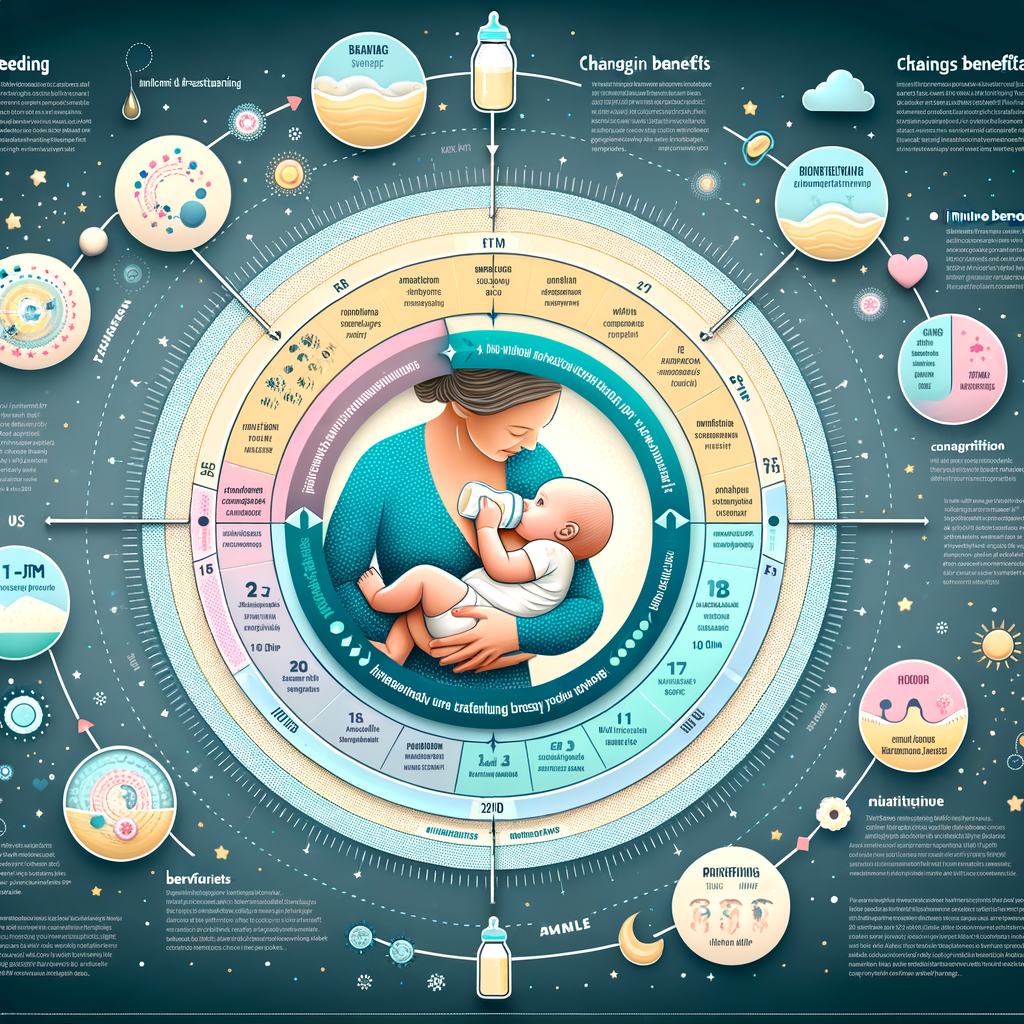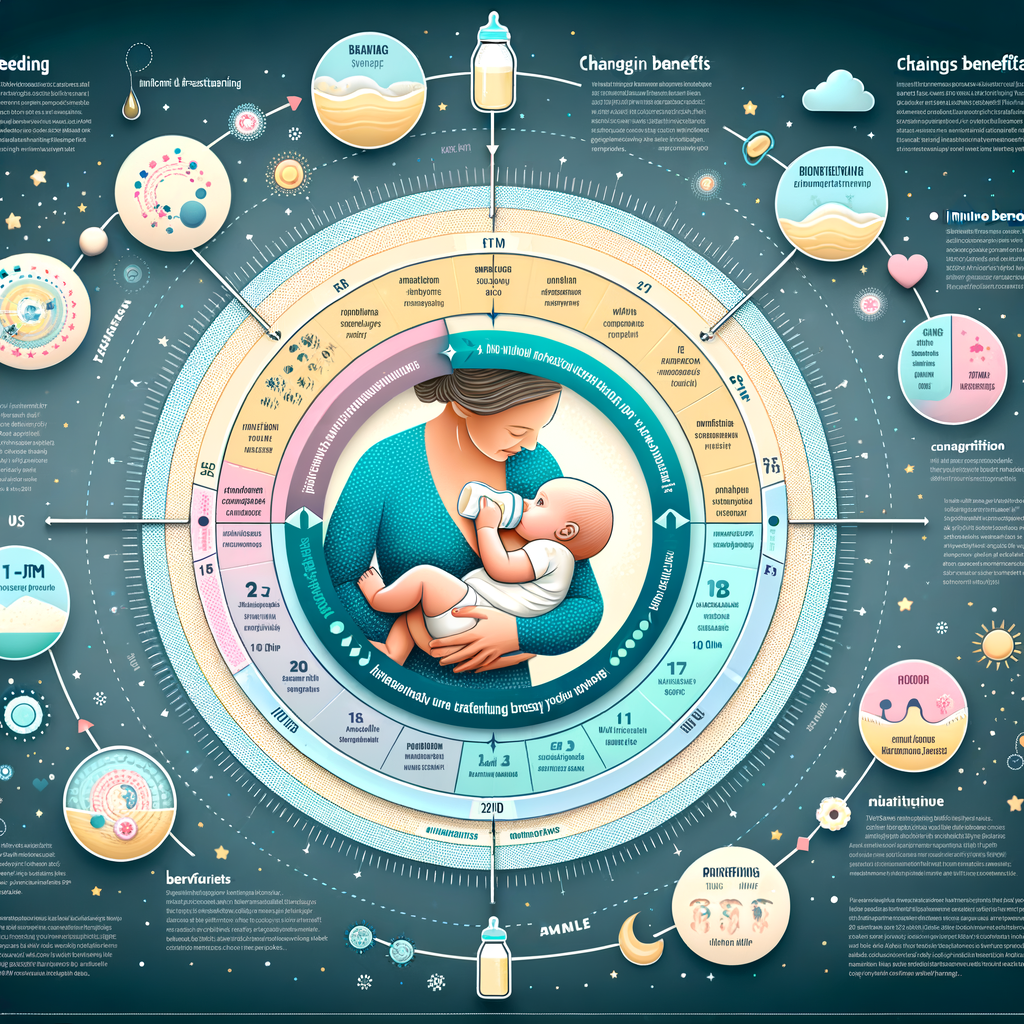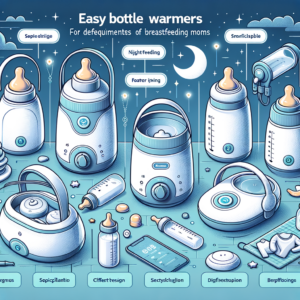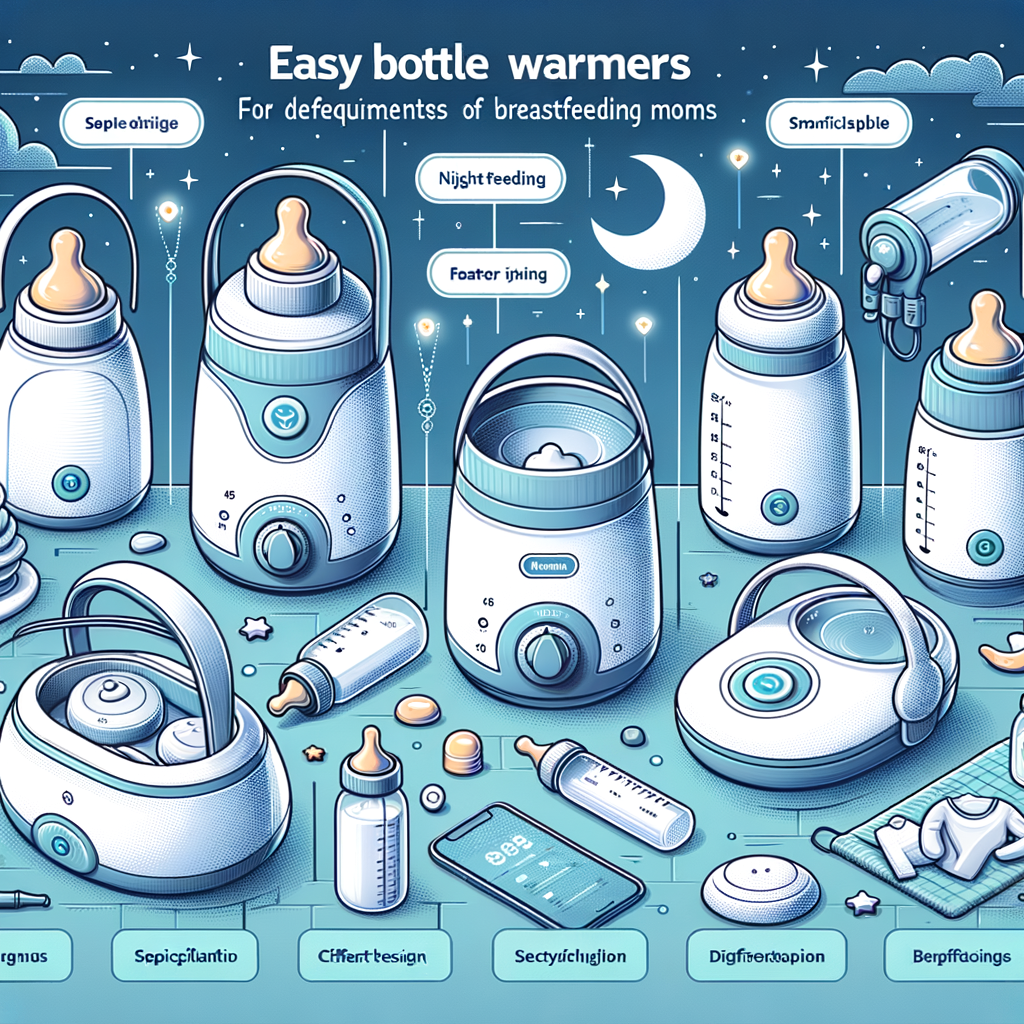
Introduction to Breastfeeding in Baby’s First Year
When a new baby arrives, one of the most important decisions a parent makes is how to feed their little one. For many, the choice is breastfeeding. This natural and beneficial method of feeding provides numerous benefits for both mother and baby. In this post, we’ll delve into the importance of breastfeeding in the first year and provide an overview of the breastfeeding journey.
- Understanding the Importance of Breastfeeding in the First Year
- Overview of the Breastfeeding Journey
Breastfeeding is more than just a method of feeding; it’s a way of nurturing your baby. The first year of life is a critical period for your baby’s growth and development. Breast milk is uniquely suited to meet these needs, providing the perfect balance of nutrients in a form that’s easy to digest. It’s also packed with disease-fighting substances that protect your baby from illness.
According to the American Academy of Pediatrics, breastfeeding can help reduce the risk of many serious health conditions, including ear infections, respiratory illnesses, and sudden infant death syndrome (SIDS). It’s also associated with long-term benefits, such as reduced risk of obesity and type 2 diabetes later in life.
The breastfeeding journey is unique for every mother and baby. It begins in the hospital or birthing center, where mothers are encouraged to start breastfeeding as soon as possible after birth. The first few days are a time of learning and adjustment as you and your baby get to know each other and establish a breastfeeding routine.
Over the first few weeks, your milk supply will increase to meet your baby’s growing needs. You’ll also start to recognize your baby’s hunger cues and establish a feeding schedule that works for both of you. As your baby grows and develops, breastfeeding will continue to provide the nutrition and comfort they need.
In the following sections, we’ll explore the changes and stages of breastfeeding in the first year, the benefits it offers, and provide a guide to help you navigate this rewarding journey. So, whether you’re a new parent or expecting, we hope this post will provide you with the information and support you need to make the most of your breastfeeding experience.
Breastfeeding Changes in the First Year
As a new mother, you may be wondering what changes to expect in your breastfeeding journey during the first year. This article will guide you through the various stages and changes that occur in breastfeeding during this critical period.
First Month: The Beginning of the Breastfeeding Journey
The first month of breastfeeding is a unique and transformative time for both you and your baby. It’s the beginning of a beautiful journey, filled with changes and adjustments.
- Initial changes in breast milk
- Understanding colostrum: the first milk
In the first few days after birth, your body produces a special type of milk called colostrum. This milk is thick, yellowish, and packed with nutrients and antibodies to protect your newborn against diseases. After a few days, your milk will start to change, becoming thinner and whiter, indicating the transition from colostrum to mature milk.
Colostrum is often referred to as ‘liquid gold’ because of its rich, golden color and the invaluable nutrients it provides. It’s low in fat, high in carbohydrates, protein, and antibodies, making it the perfect first food for your baby. Colostrum also helps your newborn’s digestive tract develop and prepare itself to digest breast milk and other foods later on.
Remember, every mother’s breastfeeding journey is unique, and these changes are a normal part of the process. Embrace this journey and know that you are providing the best nutrition for your baby.
3-6 Months: Breastfeeding Progression
As your baby grows, so does their appetite and the composition of your breast milk. This stage of breastfeeding is a time of change and adaptation for both you and your baby.
- Changes in Milk Composition
During the first few months of your baby’s life, your breast milk is perfectly tailored to their needs. But as they grow, the composition of your milk changes too. It becomes richer in protein and fat, providing the energy your baby needs for their rapid growth and development. It’s a fascinating process, isn’t it?
- Adjusting to Baby’s Growing Appetite
As your baby grows, so does their appetite. You might notice that your baby wants to feed more often, or for longer periods. This is completely normal. Your body will naturally adjust to produce more milk to meet your baby’s growing appetite. It’s important to continue breastfeeding on demand, as this will ensure your milk supply keeps up with your baby’s needs.
| Age | Milk Composition | Feeding Frequency |
|---|---|---|
| 3-6 months | Richer in protein and fat | Increased, as per baby’s demand |
Remember, every baby is unique and will develop at their own pace. These are general guidelines and may not apply to every baby. Always consult with a healthcare professional if you have concerns about your baby’s feeding or growth.
6-12 Months: Continued Breastfeeding Development
As your baby grows older, the breastfeeding journey continues to evolve. Between 6 to 12 months, there are two significant developments: the introduction of solid foods and the continued changes in breast milk. Let’s delve into these topics.
- Introduction of Solid Foods and its Effect on Breastfeeding
At around six months, most babies are ready to start trying solid foods. This is an exciting time for both mom and baby, but it can also bring about changes in breastfeeding.
When your baby starts eating solid foods, they might start to breastfeed less often. This is perfectly normal. Your body will adjust to this change by producing less milk. However, breastfeeding should still remain a key part of your baby’s diet. It provides important nutrients and helps to strengthen the bond between you and your baby.
Remember, every baby is different. Some might take to solid foods right away, while others might need a little more time. It’s important to be patient and follow your baby’s lead.
- Continued Changes in Breast Milk
Even as your baby starts to eat solid foods, your breast milk continues to change and adapt to your baby’s needs. It’s truly amazing!
During this stage, your breast milk will contain a higher concentration of proteins and fats, which are essential for your baby’s growth and development. It also continues to provide important antibodies that help protect your baby from illness.
Keep in mind, the more you breastfeed, the more milk your body will produce. So even though your baby is eating solid foods, it’s still important to continue breastfeeding.
In conclusion, the 6-12 month stage is a time of exciting changes in your breastfeeding journey. Remember, every mom and baby are unique. What’s most important is to do what feels right for you and your baby.
Breastfeeding Stages in the First Year
Understanding the stages of breastfeeding in the first year can help new mothers navigate this important journey. Let’s start with the newborn stage.
Newborn Stage
The newborn stage is a crucial time for both mother and baby. During this time, the frequency of feeding and understanding latch and positioning are vital aspects to consider.
- Frequency of feeding: In the first few weeks, newborns typically need to be breastfed every 2-3 hours, around the clock. This could mean 8 to 12 feedings in a 24-hour period. Remember, every baby is unique, and this frequency may vary. It’s essential to feed your baby whenever they show signs of hunger, such as increased alertness or activity, mouthing, or crying.
- Understanding latch and positioning: Proper latch and positioning are key to successful breastfeeding. When your baby has a good latch, it helps ensure they get enough milk and prevents discomfort during feeding. To achieve a good latch, make sure your baby’s mouth is wide open before bringing them to your breast. The baby’s lips should be flanged outwards, and more of your areola should be visible above your baby’s lip than below it. There are several breastfeeding positions you can try, such as the cradle hold, football hold, or side-lying position. Find a position that feels comfortable for you and your baby.
Remember, breastfeeding is a learning process for both mother and baby. It’s okay to ask for help and seek advice from healthcare professionals if you’re having difficulties.
Infant Stage
As your baby grows, you’ll notice some changes in their feeding patterns and sleep schedules. This is a normal part of their development. Let’s explore these changes and how you can manage them effectively.
- Changes in Feeding Patterns
During the infant stage, your baby’s stomach has grown, and they can consume more milk at each feeding. This means they may start to feed less frequently but for longer periods. It’s important to remember that each baby is unique and may not follow a strict pattern.
Some babies may start to show interest in solid foods at this stage. However, the American Academy of Pediatrics recommends exclusive breastfeeding for the first six months. After this, you can start introducing solids while continuing to breastfeed.
- Managing Feeding and Sleep Schedules
As your baby grows, their sleep patterns will also change. They will start to sleep for longer periods at night and have fewer naps during the day. This can affect their feeding schedule.
It’s important to feed your baby on demand, especially during growth spurts when they may need more milk. You can also start to introduce a bedtime routine, which can include a feeding session. This can help signal to your baby that it’s time to sleep.
Remember, managing feeding and sleep schedules can be a challenge, but you’re doing a great job! Always consult with your healthcare provider if you have any concerns.
| Age | Feeding Frequency | Sleep Duration |
|---|---|---|
| 4-6 months | 4-5 times a day | 14-15 hours a day |
| 6-9 months | 3-4 times a day (plus solids) | 14 hours a day |
| 9-12 months | 3 times a day (plus solids) | 14 hours a day |
These are general guidelines and may vary from baby to baby. Always follow your baby’s cues and consult with your healthcare provider for personalized advice.
Baby Stage
As your baby grows, their nutritional needs change. This is the stage where you will start introducing them to solid foods while maintaining breastfeeding. Let’s delve into this exciting phase.
- Transitioning to Solid Foods
Introducing your baby to solid foods is a significant milestone. It’s an exciting time for both you and your baby. However, it’s important to remember that every baby is different, and they will be ready for solids at their own pace.
Most babies are ready to start solids between 4 and 6 months. You can look for signs such as your baby being able to sit up unassisted, showing interest in your food, and losing the tongue-thrust reflex that pushes food out of their mouth.
Start with pureed foods like fruits and vegetables. Introduce one food at a time and wait a few days before introducing another. This way, you can monitor for any allergic reactions.
Remember, the transition to solid foods is a gradual process. It’s not about replacing breast milk but complementing it.
- Maintaining Breastfeeding Alongside Solids
Even as you introduce solid foods, it’s important to continue breastfeeding. Breast milk continues to provide essential nutrients and immune support, even as your baby starts eating solid foods.
Try to breastfeed before offering solids. This way, your baby fills up on breast milk first, which is still the most important source of nutrition.
As your baby gets more used to eating solids, you can start adjusting feeding times. You might find that your baby naturally starts to breastfeed less often.
Remember, every baby is unique, and there’s no one-size-fits-all approach. Listen to your baby’s cues and consult with your pediatrician if you have any concerns.
Transitioning to solids while maintaining breastfeeding can be a balancing act, but with patience and flexibility, you and your baby can navigate this stage successfully.
Benefits of Breastfeeding in the First Year
There are numerous benefits of breastfeeding in the first year of a baby’s life. These benefits extend not just to the baby, but also to the mother. Let’s explore these benefits in detail.
- Nutritional benefits for the baby
- Ear infections
- Diarrhea and vomiting
- Sudden Infant Death Syndrome (SIDS)
- Childhood leukemia
- Obesity
- Type 2 diabetes
- Health benefits for the mother
- Lower risk of postpartum depression
- Lower risk of certain types of cancer including breast and ovarian cancer
- Faster return to pre-pregnancy weight
- Delayed menstruation with increased natural birth-control benefits
- Emotional benefits for both mother and baby
Breast milk is often referred to as the ‘perfect food’ for a baby’s digestive system. It contains the vitamins and nutrients that a baby needs in the first six months of life, and it’s packed with disease-fighting substances that protect your baby from illness. According to the American Academy of Pediatrics, breastfeeding can help reduce the risk of many diseases in babies, including:
Breastfeeding doesn’t just benefit the baby. Mothers who breastfeed can also experience health benefits. These may include:
Breastfeeding can be a beautiful bonding experience between mother and baby. The skin-to-skin contact can boost the mother’s oxytocin levels, which helps milk flow and can help with infant attachment. The baby can also feel more secure, warm and comforted.
In conclusion, breastfeeding in the first year offers a multitude of benefits for both mother and baby. It provides optimal nutrition for the baby, health benefits for the mother, and emotional bonding for both.
First Year Breastfeeding Guide
As a new mother, breastfeeding can be a challenging journey. However, with the right guidance and knowledge, you can overcome these challenges and ensure a healthy growth for your baby. In this guide, we will discuss some common breastfeeding challenges and how to overcome them.
Overcoming Common Breastfeeding Challenges
During the first year of breastfeeding, you might encounter a few challenges. Here are three common ones and some tips on how to deal with them:
- Dealing with sore nipples
- Managing engorgement
- Addressing low milk supply
Sore nipples are a common problem for many breastfeeding mothers. This can be due to the baby not latching on correctly. To alleviate this, ensure your baby has a good latch. This means the baby’s mouth should cover more of the lower part of your breast than the upper part. If the pain persists, consult a lactation consultant or a healthcare provider.
Engorgement refers to the breasts becoming overly full of milk. This can be painful and make it difficult for the baby to latch on. To manage this, feed your baby often to empty your breasts. You can also use a warm compress before feeding and a cold one after to reduce swelling.
Some mothers worry about having a low milk supply. Remember, the more often and the more effectively your baby nurses, the more milk you will produce. If you’re still concerned, seek advice from a lactation consultant or your healthcare provider.
Overcoming these challenges can make your breastfeeding journey smoother and more enjoyable. Remember, every mother’s experience is unique, and it’s okay to ask for help when you need it.
Ensuring Proper Nutrition While Breastfeeding
As a breastfeeding mother, your nutrition is crucial not just for your health, but also for your baby’s growth and development. This section will guide you through the important nutrients needed and the recommended diet for breastfeeding mothers.
- Important nutrients for breastfeeding mothers
When you’re breastfeeding, your body needs extra nutrients to support both you and your baby. Here are some of the most important ones:
| Nutrient | Why It’s Important |
|---|---|
| Protein | Helps in the growth and development of your baby’s tissues and organs. |
| Calcium | Supports your baby’s bone development. |
| Vitamin D | Helps your baby absorb calcium and phosphorus for strong bones and teeth. |
| Iron | Prevents anemia and promotes healthy blood cells. |
| Folic Acid | Supports your baby’s brain and spinal cord development. |
- Recommended diet for breastfeeding mothers
Now that you know the important nutrients, let’s talk about the recommended diet. Here’s a simple guide to follow:
- Eat a variety of foods to get all the nutrients you need. Include fruits, vegetables, whole grains, lean proteins, and healthy fats in your meals.
- Drink plenty of water to stay hydrated. Breastfeeding can make you feel thirstier than usual.
- Avoid foods and drinks that can affect your baby, like alcohol and caffeine.
- If you’re vegetarian or have dietary restrictions, consider talking to a dietitian to make sure you’re getting all the nutrients you need.
Remember, the goal is not just to eat more, but to eat well. Your body is doing an amazing job, and it needs the right fuel to keep going. So, take care of your nutrition, and you’ll be taking care of your baby too.
Conclusion: Embracing the Breastfeeding Journey
As we reach the end of our discussion on breastfeeding in the first year, it’s important to take a moment to reflect on the journey and look ahead to what’s next. This journey is unique for every mother and child, filled with challenges, triumphs, and precious moments of bonding.
- Reflecting on the changes and progression of breastfeeding in the first year
In the first year, breastfeeding undergoes significant changes. From the initial stages where the baby is learning to latch and the mother is adjusting to the new routine, to the later stages where the baby starts to eat solid foods alongside breastfeeding, the journey is a continuous learning process. The frequency, duration, and even the composition of breast milk changes as the baby grows. These changes are a natural part of the breastfeeding journey, designed to meet the evolving nutritional needs of the baby.
Reflecting on this journey can help mothers appreciate the progress they have made and the invaluable nutrition they have provided to their babies. It’s also a reminder of the unique bond that breastfeeding fosters between mother and child.
- Looking forward to continued breastfeeding or weaning
As the first year comes to a close, mothers may choose to continue breastfeeding or start the process of weaning. Both paths are valid and depend on what feels right for the mother and child. If a mother chooses to continue breastfeeding, she can take comfort in the fact that breast milk continues to provide valuable nutrition and immunity benefits. If she decides to wean, it’s a gradual process that should be done at a pace that’s comfortable for both mother and baby.
Regardless of the path chosen, it’s important to remember that every breastfeeding journey is unique and should be celebrated. Whether it’s been a year filled with easy latching and abundant milk supply, or one with challenges such as sore nipples and low milk supply, every mother’s effort to nourish her child is commendable.
In conclusion, the breastfeeding journey in the first year is a remarkable one, filled with changes, growth, and deep bonding. It’s a journey that requires patience, perseverance, and a lot of love. Here’s to embracing this beautiful journey and all the joys and challenges it brings!














